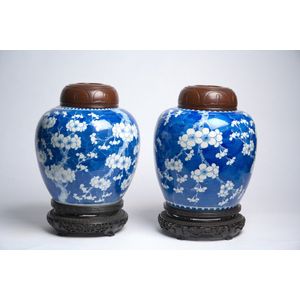Pair of Qing Dynasty Blue and White Ginger Jars
A matched pair of Chinese blue and white ginger jars, Qing Dynasty (1644-1912), first half 18th century, both decorated with plum blossom against a blue ground, dating to late Kangxi through to early Qianlong period. Together with carved hardwood lids inset with reticulated jade medallions and pierced hardwood stands. The jars each approximately 21 cm high, 20 cm diameter. Together with stand and lid approximately 30.5 cm high
You must be a subscriber, and be logged in to view price and dealer details.
Subscribe Now to view actual auction price for this item
When you subscribe, you have the option of setting the currency in which to display prices to $Au, $US, $NZ or Stg.
This item has been sold, and the description, image and price are for reference purposes only.
- Qing Dynasty - The Qing Dynasty was the last imperial dynasty of China, ruling from 1644 to 1912. It was established by the Manchu people, who originated from the northeastern region of China. The Qing Dynasty was preceded by the Ming Dynasty and followed by the Republic of China.
- Ming Dynasty - The Ming Dynasty was a ruling dynasty of China from 1368 to 1644. It succeeded the Yuan Dynasty and preceded the Qing Dynasty. The Ming Dynasty was established by Zhu Yuanzhang, a former Buddhist monk who became a rebel leader and eventually overthrew the Mongol Yuan Dynasty. During the Ming Dynasty, China experienced a period of relative stability and prosperity. The government was centralized and bureaucratic, with the emperor at the top of the hierarchy. The Ming Dynasty is known for its cultural achievements, including the development of porcelain, the invention of movable type printing, and the construction of the Great Wall of China.
This item has been included into following indexes:
- Chinese ceramics, dynasty mark or period
-
Chinese ceramics, item type
- ginger jars 235
- vases, blue ground 137
- Oriental ceramics - blue and white, jars 377
